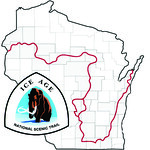The bluffs at Devil’s Lake State Park are part of the Baraboo Range. Scientist believe they are one of the oldest outcrops in North America because they were formed 1.6 billion years ago.
Quartzite is created through a number of steps:
- Sand is deposited by rivers into shallow seas.
- Accumulation of the sand creates porous sedimentary rock known as sandstone.
- The sandstone is subjected to a great heat and pressure which changes it to non-porous metamorphic quartzite rock.
After the seas withdrew, the quartzite buckled upward creating ranges with a depression between. About 15,000 years ago, the Wisconsin glacier covered the eastern half of the Baraboo hills. The glacier dropped rocks and gravel moraines which re-routed the Wisconsin River away from the Devil’s Lake gap. Then moraines deposited at the north and south open ends of the gap created the Devil’s Lake basin; unique in the entire world. This lake has no natural drainage outlet and the water in it comes solely by local drainage and springs. The bluffs rise 500 feet above the lake level.
Exposed quartzite outcrops that were not covered by glacial ice were subject to freezing and thawing conditions. Water in rock cracks expanded as it froze, eventually breaking off the bluffs and created fragile quartzite features. Devil’s Doorway is one such feature. Balanced Rock (also an EarthCache site in the Park – GC2KA27) is another such feature.
 IATCC is the cache designation to highlight a series of EarthCaches along the Ice Age National Scenic Trail grouped into a special category called "ColdCache."
IATCC is the cache designation to highlight a series of EarthCaches along the Ice Age National Scenic Trail grouped into a special category called "ColdCache."
The Ice Age Trail is one of eleven National Scenic Trails designated by the National Park Service. This unique trail is entirely within the state of Wisconsin and follows along the terminal moraine of the most recent glacier which retreated about 10,000 years ago.
This project is supported by the Ice Age Trail Alliance (IATA). The goal is to bring more visitors to the trail and promote public awareness, appreciation, and understanding of Wisconsin’s glacial landscape.
The IATA has created an awards program to encourage visits to the trail and ColdCache sites. This awards program is separate from, and in addition to, any other Geo- or EarthCache awards program.
A current list of approved ColdCache sites can be found on the “IATCC Bookmark List”. More information on the Ice Age Trail Atlas, the Companion Guide, the ColdCache Project and Awards Program can be found on the “ColdCache Webpage”
The Geocache Notification Form has been submitted to Steve Schmelzer of the Wisconsin DNR. Geocaches placed on Wisconsin Department of Natural Resource managed lands require permission by means of a notification form. Please print out a paper copy of the notification form, fill in all required information, then submit it to the land manager. The DNR Notification form and land manager information can be obtained at: www.wi-geocaching.com/hiding
Resources
Devil’s Lake State Park Visitor Guide; Wisconsin Dept. of Natural Resources; Pub – PR-111-2013
Geology of the Ice Age National Scenic Trail; by David M. Mickelson, Louis J. Mahler Jr., and Susan L. Simpson
Wisconsin Department of Natural Resources; Devils Lake Geology
To claim this find:
- From the designated viewpoint, which direction are you facing when you look through the doorway?
- Observe the doorway and speculate if it is made up of; a) talus – rock that has tumbled down the bluff and landed in it’s current position, b) non-talus – it was once part of a much larger rock formation, or c) a combination of talus and non-talus. Explain your answer.